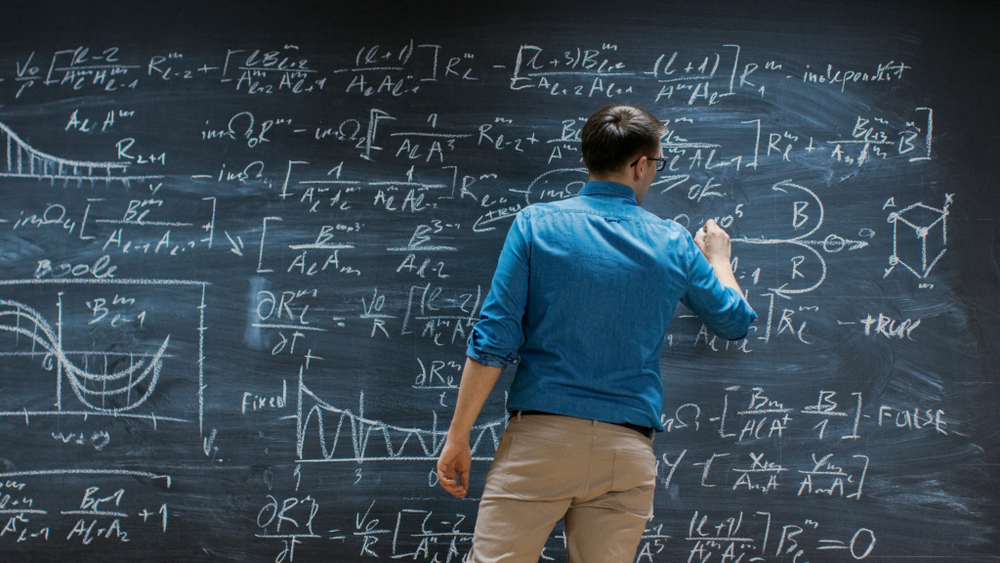Two Punches Unlocked His Hidden Math Genius: Inside Jason Padgett’s Fractured Mind

Jason Padgett pours cream into his morning coffee. Most people see a swirl of white mixing with brown. He sees perfect spirals, fractals speaking geometry’s secret language. Every drop forms mathematical patterns that build our universe. Light bouncing off his car window proves pi exists. Tree leaves outside demonstrate Pythagoras lived and breathed truth.
Padgett didn’t always see reality through mathematical eyes. Twelve years ago, he counted bicep curls at the gym, tallied bar tabs, and tracked hours until his shift ended at his father’s furniture store. Math meant nothing. Academics meant less. Two strangers changed that with their fists on a September night that rewired his brain forever.
Friday Night Changed Everything

September 13, 2002, started like any other Friday for 31-year-old Padgett. Karaoke bar near his Tacoma home, friends laughing, drinks flowing. Party mode engaged. Around closing time, two men approached him from behind.
Fists connected with the back of his skull. Padgett dropped, unconscious before hitting the ground. Kicks and punches rained down while he lay defenseless. His attackers wanted his leather jacket. Worthless fashion statement from another decade, but they took it anyway after beating him senseless.
Hospital staff ran a CT scan, found a bruised kidney, and sent him home that same night. Doctors called it a concussion. Nobody suspected his brain had fundamentally changed. Nobody imagined he’d wake up seeing mathematics everywhere.
Morning brought revelation. Water flowing from his bathroom tap didn’t look right. Or rather, it looked more right than ever before. “I watch the cream stirred into the brew. The perfect spiral is an important shape to me. It’s a fractal. Suddenly, it’s not just my morning cup of joe, it’s geometry speaking to me,” Padgett would later explain about his transformed vision.
Lines shot out perpendicular from the water flow. Beautiful, terrifying, impossible lines that shouldn’t exist in ordinary reality. He stood frozen in his slippers, staring at patterns nobody else could see.
Meet the Guy Before His Brain Got Rewired

Picture a man trapped in 1985 despite living in 2002. Mullet flowing, leather vest open to bare chest, pants painted on. Padgett embodied every outdated party-guy stereotype while pushing into his thirties with a daughter at home.
College dropout status didn’t bother him. Tacoma Community College became a distant memory, replaced by his father’s furniture store and endless nights of manufactured excitement. Red Camaro freshly painted, ready to race. Cliff-jumping weekends, skydiving adventures, bar-hopping marathons.
Math existed only in its most basic forms. Count the beers. Calculate the tab. Track gym reps. Pre-algebra marked his mathematical peak in high school, despite scoring well on elementary school IQ tests. Academic pursuits held zero appeal. Books gathered dust while bottles of Southern Comfort slipped into jacket pockets to avoid six-dollar bar drinks.
Life revolved around adrenaline and avoiding responsibility. Padgett lived for the rush, the party, the next thrill. He assumed this cycle would spin forever.
Geometry Started Speaking to Him
Every movement of Padgett’s hand now played like stop-motion animation. Slow, deliberate frames replacing fluid motion. Days passed, but the visual changes persisted. Windows became perfect rectangles demanding attention. Spoons curved according to mathematical rules he’d never learned but somehow understood.
Numbers grew colorful shapes when he looked at them. Not metaphorically. Actual shapes, actual colors, superimposed over digits like augmented reality before smartphones existed. His house transformed into a living mathematics textbook written in a language his brain suddenly comprehended.
Work became impossible. How could he sell furniture when every piece screamed geometric principles? Instead, he devoured books about math and physics. Fractals captured his imagination. Pi became an obsession. A man who’d avoided academics for decades now couldn’t stop learning.
When Fractals Take Over Your Life

Drawing became compulsion. Despite never showing artistic ability before, Padgett’s hand moved as if guided by an external force. Perfect geometric patterns flowed from his pencil. Not approximately perfect. Actually perfect, or he’d start over.
One drawing required 720 hand-drawn triangles forming a circle, demonstrating his newfound understanding of pi. Another visualization depicted Hawking radiation emitting from a micro black hole. Nine months of work for a single image. Some drawings took days. Others consumed weeks. Each line had to align exactly, or the entire piece would be scrapped.
Light bouncing off car windows suddenly made sense as mathematical proof. Each ray subdividing circles, representing pi in action. Revelations struck like lightning. During one meditation session, a thought exploded: circles don’t exist. Not really. Only polygons with infinite sides creating the illusion of curves.
“It was like a bomb went off in my mind. In a matter of minutes, I was no longer just a receiver of geometric imagery or a researcher; I was a theorist,” he would write in his memoir years later.
You’re One of Only 40 People Like This
Padgett joined an exclusive club nobody wants to enter. Acquired savant syndrome affects roughly 40 people worldwide. Unlike savants born with extraordinary abilities, acquired savants develop theirs after brain trauma. Lightning strikes, baseball impacts, car crashes, bar fights. Regular people becoming accidental geniuses through violence or disaster.
Consider the membership roster. Orlando Serrell, struck by a baseball at age 10, suddenly able to name any day of the week for any date. Dr. Anthony Cicoria, hit by lightning, transformed into a concert-level pianist without training. Alonzo Clemens, IQ of 40, fell on his head and gained the ability to sculpt any animal in perfect detail after seeing it once.
Dr. Darold Treffert, Wisconsin psychiatrist and world expert on savantism, studied Kim Peek (Rain Man’s inspiration) and coined the term “savant syndrome” to replace outdated, offensive terminology. When Padgett reached out via email, Treffert confirmed what seemed impossible: acquired savant syndrome. One of only 30 identified cases at that time.
Price Tag on Genius: Fear and Isolation

Gifts often carry curses. Padgett’s mathematical awakening came bundled with paranoia and isolation. Blankets covered windows, nailed shut against a world that suddenly felt dangerous. Visitors turned away. Germs became enemies requiring constant hand-washing until skin turned raw and bled.
His own daughter couldn’t receive hugs without washing her hands first. Love filtered through obsessive-compulsive rituals. Social butterfly transformed into hermit. Party animal became prisoner of his own enhanced perception.
Mental illness seemed the logical explanation. What else could explain seeing mathematical patterns everywhere? Fear crept in that the beating had broken something essential, not enhanced it. Loneliness compounded by the inability to share what he saw with anyone who’d understand.
Finding Your Tribe Changes Everything

Salvation arrived through television. A BBC documentary featured Daniel Tammet reciting pi to the 22,514th digit. Tammet, an autistic savant with synesthesia, saw numbers as colors and shapes. Just like Padgett.
Google searches revealed more acquired savants. Email to Dr. Treffert brought professional validation. Not crazy. Not broken. Changed. Enhanced. Different.
Blankets came down from windows. Sunlight returned. Community college enrollment followed. If others could live with these abilities, so could he.
Scientists Scan the Rewired Brain

2011 brought scientific confirmation. Dr. Berit Brogaard, now directing the Brogaard Lab for Multisensory Research at the University of Miami, invited Padgett to Finland. Three days of brain scans and tests using fMRI machines and transcranial magnetic stimulation.
Results showed his right brain compromised, left hemisphere hyperactive. His left parietal lobe, where neuroscientists locate mathematical processing, blazed with activity. Brain specialization taken to extremes.
Theories emerged about the mechanism. Trauma flooded his brain with neurotransmitters, restructuring neural connections. Perhaps he tapped into “genetic memory,” the same instinctual programming that tells birds to fly in V-formations. Brain regions normally suppressed in healthy adults suddenly freed to operate.
Research suggests bilateral parietal lobe activation (both sides working together) actually correlates with worse math performance. Brains prefer specialization. Padgett’s brain specialized with vengeance.
Your Hidden Einstein Might Be Sleeping
University of Sydney experiments suggest everyone harbors dormant abilities. Researchers developed a “thinking cap” that temporarily suppresses certain brain regions. Wearing it, ordinary people draw with greater detail, spot errors in text more easily, solve complex puzzles faster, estimate large quantities more accurately.
Effects vanish an hour after removing the device, but implications remain staggering. Allan Snyder, author of these studies, concluded savant skills exist latently in everyone. We all possess hidden genius waiting for activation.
Consider daily life’s hidden calculations. Reaching for coffee while reading requires your brain to compute distance, weight, velocity, trajectory. Complex mathematics happening unconsciously every second. Padgett simply gained conscious access to processes that normally run in the background.
“One could speculate that [Padgett] has better access to these areas than the rest of us,” Dr. Brogaard observed after studying his brain.
Circles Don’t Exist (And Other Revelations)
Mathematical reality replaced ordinary perception. Tree leaves demonstrated Pythagorean principles through their branching patterns. Arc of light proved pi’s existence. Coffee cream spirals revealed fractal geometry underlying everything.
Tim Chartier, mathematics professor at Davidson College, reviewed Padgett’s drawings with amazement. Padgett reminded him of Srinivasa Ramanujan, the self-taught mathematical genius who revolutionized number theory without formal training.
Yet limitations exist. Padgett sees mathematical reality but needs trained mathematicians to formalize his visions into proofs. He won’t win a Fields Medal. His genius lies in perception, not necessarily in advancing mathematical theory.
Still, his drawings capture something extraordinary. Hand-drawn fractals that normally require computers. Visualizations of complex physics concepts that take months to complete. Windows into mathematical reality most humans never glimpse.
Would You Trade Places?
Asked whether he’d return to his old life, Padgett paused. The answer came quick and definitive: No.
Then honesty crept in. Sometimes he misses the “blissful ignorance of life before.” Knowledge carries weight. Seeing reality’s mathematical skeleton means never again experiencing simple, unexamined existence.
Yet boredom died that September night. Wonder replaced it. Every moment contains infinite complexity. Dreams arrive in geometric form. Morning coffee becomes a lesson in fluid dynamics and fractal patterns.
“I believe I am living proof that these powers lie dormant in all of us,” Padgett writes. “If it could happen to me, it could happen to anyone.”
Dr. V.S. Ramachandran from UC San Diego’s Center of Brain and Cognition admits how little we understand our three-pound organs. These anomalies, these accidental savants, reveal our ignorance about human potential.
Perhaps we all walk around with sleeping genius, waiting for activation. Perhaps ordinary people possess extraordinary abilities locked behind neural barriers. Perhaps transformation waits one trauma away, though nobody should seek it through violence.
Padgett’s story raises uncomfortable questions. Would enhanced perception bring happiness or isolation? Does seeing reality’s mathematical truth improve life or complicate it? Can consciousness expand without losing something essential?
Morning coffee swirls in his cup. Fractals dance where cream meets caffeine. Geometry speaks its ancient language to a furniture salesman turned mathematical prophet. He listens, draws what he sees, and reminds us that human potential exceeds our wildest calculations. Even if circles don’t really exist.
Loading...

